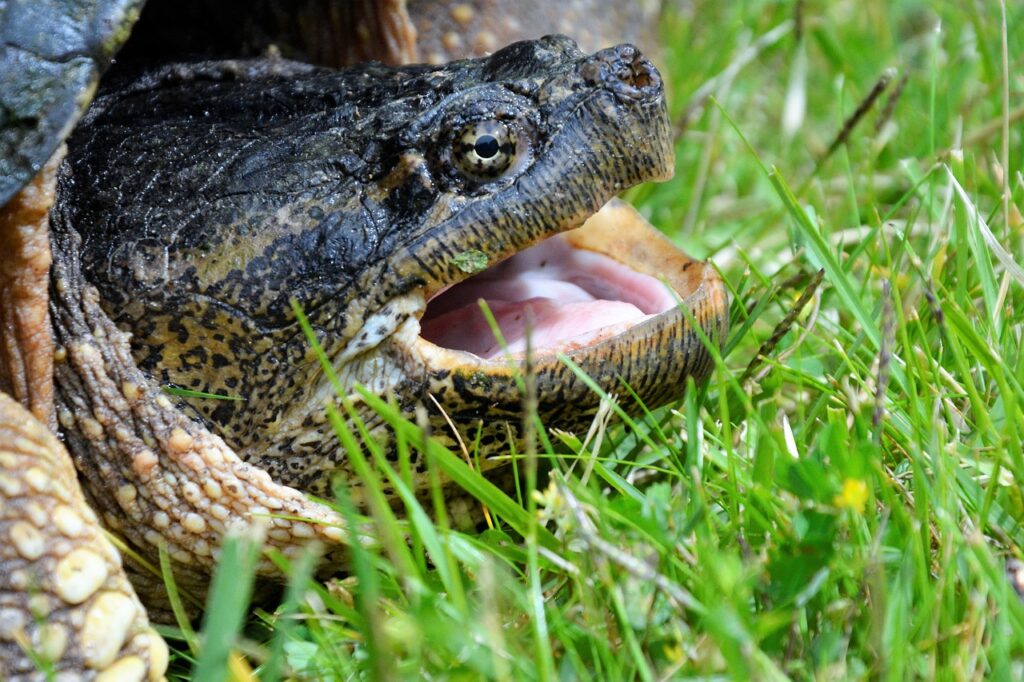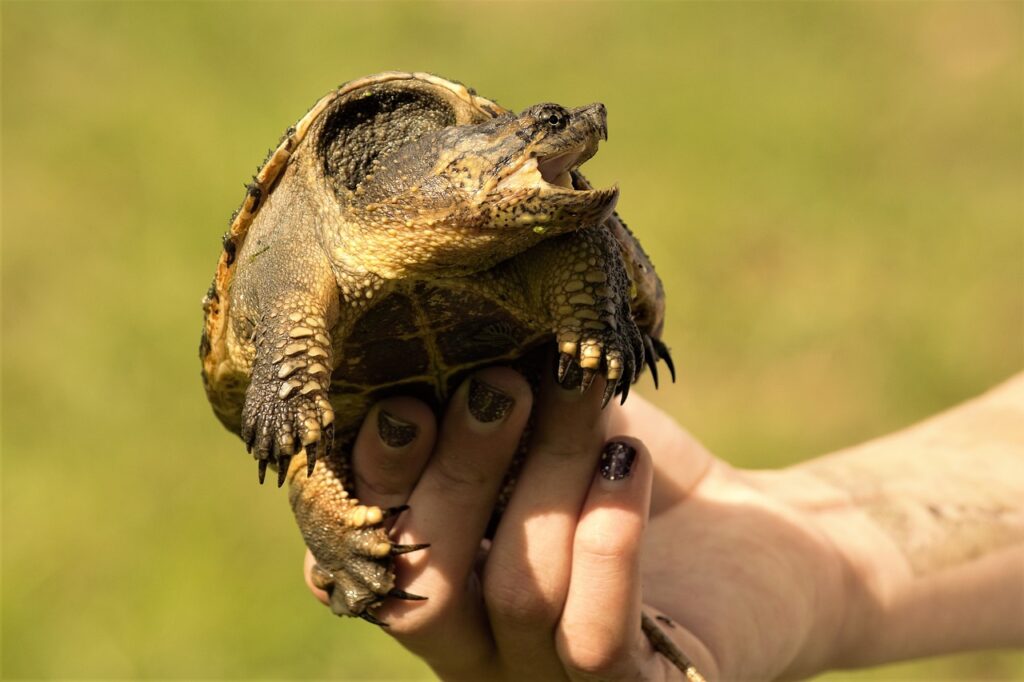Are you curious about how to identify a snapping turtle? Look no further! In this article, you will discover simple yet effective ways to distinguish whether that mysterious reptile lurking near the pond is indeed a snapping turtle. By focusing on key physical features such as its shell, head, and tail, you will soon become a pro at recognizing these fascinating creatures. So, grab a pen and paper, and let’s dive into the world of snapping turtles!

Physical Characteristics
Shell
The shell of a snapping turtle is one of its most distinctive features. It has a rugged, bumpy appearance and is deeply notched at the rear, which allows its long tail to move freely. The shell can vary in color, ranging from dark brown to black or olive green, and is covered in a combination of rough, ridged scutes and a layer of algae or moss. The shell is incredibly strong and provides excellent protection for the turtle’s vital organs.
Head
The head of a snapping turtle is large and powerful, with a hooked beak-like mouth filled with sharp, pointed jaws. This unique feature is where the snapping turtle gets its name. Its jaws are incredibly strong and can deliver a powerful bite, so caution should always be exercised when approaching or handling these turtles. The head is usually dark brown or black in color, often with yellow or red markings.
Legs and Tail
The legs of a snapping turtle are stout and muscular, with sharp claws that it uses for digging and gripping. The front legs have five toes, while the back legs have four. These limbs are well-adapted for both swimming and walking on land. The tail of a snapping turtle is long and thick, with a series of jagged spines running along the top. This tail is primarily used for swimming and acts as a rudder to help maneuver through the water.
Behavior
Aggression
Snapping turtles have a well-deserved reputation for being aggressive, especially when they feel threatened or cornered. They are solitary animals by nature and prefer to be left alone. However, if approached or handled improperly, they can become defensive and may resort to biting as a means of defense. It is important to treat snapping turtles with caution and respect and to avoid any unnecessary interactions.
Basking
Like many reptiles, snapping turtles engage in basking behavior. They will often be seen on logs or rocks, partially submerged in water, to absorb warmth from the sun. Basking serves several purposes for snapping turtles, including thermoregulation, vitamin D synthesis, and external parasite removal. It is during these basking sessions that their distinctive shells and heads may be more easily observed.
Feeding
Snapping turtles are opportunistic carnivores and have a broad diet. Their diet primarily consists of aquatic organisms such as fish, frogs, snakes, insects, and various types of smaller prey. They are also known to scavenge on carrion. Snapping turtles have a unique feeding strategy—they lie motionless underwater and use their jaws to snatch prey that ventures too close. They have a strong sense of smell, which helps them locate potential food sources.
Habitat
Geographical Distribution
Snapping turtles are native to North America and can be found throughout the United States and Canada. They have a wide distribution and are particularly prevalent in the eastern and central parts of North America. While they are most commonly found in freshwater habitats, they can also occasionally be observed in brackish or saltwater environments.
Freshwater Habitats
Snapping turtles are primarily aquatic reptiles, preferring freshwater habitats such as lakes, ponds, rivers, and swamps. They are highly adaptable and can inhabit a variety of freshwater ecosystems, from calm, slow-moving bodies of water to more turbulent and fast-flowing streams. They are often found near vegetation, fallen logs, or other submerged structures that provide them with hiding places and basking spots.
Land Habitats
Despite being aquatic creatures, snapping turtles also spend a significant amount of time on land. They will venture out of the water to find suitable nesting sites, and occasionally, they may travel between bodies of water. Snapping turtles have been known to migrate overland, and there are even accounts of them venturing onto roads in search of nesting sites. They can also survive in terrestrial habitats such as marshes, meadows, and forests.
Diet
Carnivorous Feeding
Snapping turtles are fierce carnivores and exhibit a wide range of feeding behaviors. They use their powerful jaws to capture and consume a variety of prey. Their diet includes fish, amphibians, reptiles, birds, small mammals, and even other turtles. Snapping turtles have a unique feeding technique called “lingual luring.” They wiggle their tongue to attract fish, mimicking a worm or insect, and when an unsuspecting fish comes close, they snap their jaws shut with incredible speed and force.
Prey Preferences
While snapping turtles are opportunistic feeders, they do have certain preferences when it comes to prey. They tend to favor fish, especially slower-moving species that are easier to catch. Amphibians, such as frogs and salamanders, also make up a significant portion of their diet. Snapping turtles are known to be scavengers as well, feeding on dead animals they come across. They will consume almost anything they can overpower and fit into their mouths.

Reproduction
Breeding Season
The breeding season for snapping turtles typically occurs in the spring or early summer, usually between April and June, depending on the geographical location and local climate. During this time, male snapping turtles become more active and begin to search for potential mates. They often engage in elaborate courtship displays to attract females, including head bobbing, extended neck displays, and circling movements in the water.
Mating Behavior
Once a male snapping turtle successfully attracts a female, mating takes place in the water. The male mounts the female from behind, using his long tail to help maintain his position. Mating can last several hours, with the male occasionally biting the female’s head as a display of dominance. After mating, the female will begin to prepare for nesting.
Nesting
Snapping turtles are known for their impressive nests. Female snapping turtles will typically lay their eggs in sandy or loose soil, digging a hole with their hind legs. The nests are often located in sunny areas near water bodies. Snapping turtles are somewhat unique in that they do not build elaborate nests like some other turtle species. Instead, they rely on the surrounding environment to provide optimal conditions for incubation.
Life Cycle
Egg Development
After a female snapping turtle lays her eggs, she carefully covers them with soil to protect them from predators and the elements. Snapping turtle eggs have a relatively long incubation period, usually ranging from 60 to 90 days. The gender of the hatchlings is determined by the temperature at which the eggs are incubated, with higher temperatures resulting in more females and lower temperatures favoring males.
Hatchling Stage
When the eggs hatch, the tiny snapping turtle hatchlings emerge from the nest and instinctively make their way towards the nearest water source. This journey can be perilous, as they are highly vulnerable to predators during this stage. Their small size and soft shells make them easy targets, which is why many hatchlings do not survive to adulthood. Once they reach the water, they face a new set of challenges as they adapt to their aquatic environment.
Juvenile and Adult Stage
As snapping turtles grow, they become more adept at navigating their surroundings and avoiding predation. In their juvenile stage, they may spend more time in shallow waters and near shorelines, gradually venturing into deeper water as they mature. The growth rate of snapping turtles can vary depending on factors such as diet, habitat conditions, and genetics. With proper care and survival, snapping turtles can live for several decades in the wild.

Threats and Conservation
Habitat Destruction
One of the biggest threats to snapping turtles is habitat destruction. As human populations expand, the wetlands, marshes, and other freshwater habitats that snapping turtles rely on for survival are being destroyed or degraded. Urban development, pollution, and the draining of wetlands for agricultural purposes all contribute to the loss of suitable habitat for these turtles. As their habitat continues to shrink, snapping turtles face increased challenges in finding suitable places to live and reproduce.
Hunting and Harvesting
Snapping turtles have historically been harvested for their meat, eggs, and shells. In some regions, they have been heavily exploited for commercial purposes. While hunting and harvesting practices have become more regulated in recent years, illegal poaching and high demand for their meat still pose a threat to their populations. The collection of snapping turtle eggs can also have detrimental effects on their reproductive success, as it reduces the number of individuals reaching adulthood.
Conservation Efforts
In recognition of the threats facing snapping turtles, conservation efforts have been put in place to protect these remarkable creatures. Many conservation organizations are actively involved in initiatives to preserve and restore wetland habitats, raising awareness of the importance of these ecosystems and their inhabitants. Conservation programs also focus on educating the public about the need to respect and coexist with snapping turtles. Additionally, tighter regulations and laws have been implemented to control the hunting and harvesting of snapping turtles, providing them with legal protection.
Common Misidentifications
Snapping Turtle vs. Common Snapper
One common misidentification is between snapping turtles and common snappers. However, it is essential to clarify that snapping turtles and common snappers actually refer to the same species, Chelydra serpentina. These terms are often used interchangeably, with “snapping turtle” being the more widely recognized name. So, if someone mentions a common snapper, they are referring to the same turtle that is commonly known as a snapping turtle.
Snapping Turtle vs. Softshell Turtle
Another common misidentification occurs between snapping turtles and softshell turtles. While both belong to the order Testudines, they have distinct physical characteristics. Snapping turtles have a hard, rugged shell, whereas softshell turtles, as the name suggests, have a relatively softer shell. Snapping turtles also have a more prominent hooked beak-like mouth compared to the flat, elongated snouts of softshell turtles.
Snapping Turtle vs. Painted Turtle
Snapping turtles and painted turtles are often confused due to their overlapping habitat preferences. However, these two species have several key differences. Snapping turtles are much larger, with a distinctively rough shell, while painted turtles are smaller, with a smooth, brightly colored shell. Additionally, painted turtles have a more omnivorous diet, including a significant portion of plant matter, whereas snapping turtles are primarily carnivorous in their feeding habits.

Interaction with Humans
Handling with Caution
When encountering a snapping turtle, it is important to exercise caution and approach with respect. Snapping turtles can become defensive if they feel threatened, and their powerful bite can cause serious injury. If you need to handle a snapping turtle, it is recommended to do so with protective gloves or by grasping the shell near the tail, avoiding the head and jaws. However, it is generally best to observe snapping turtles from a safe distance and appreciate them in their natural habitat.
Environmental Considerations
To support snapping turtle conservation efforts, it is crucial to be mindful of the impact humans have on their environment. Avoiding the destruction of wetlands, reducing pollution, and minimizing disturbance in their habitats are all actions that can help protect these turtles and the ecosystems they inhabit. Additionally, individuals can contribute to conservation by participating in citizen science projects, joining local environmental organizations, or supporting initiatives that promote the preservation of wetlands.
Encountering a Snapping Turtle
If you come across a snapping turtle in the wild, it is best to observe from a distance and allow it to go about its business undisturbed. Never attempt to handle or capture a wild snapping turtle unless you are trained and experienced in doing so. If you encounter a snapping turtle crossing a road, exercise caution and help it cross safely in the direction it was heading. But remember, snapping turtles can be quite quick and aggressive when handled, so it is essential to prioritize your safety and the welfare of the turtle.
Legal Status
Protected Species
Snapping turtles are protected in various regions, and their legal status can vary depending on local and state regulations. In some areas, they are considered a species of special concern due to declining populations and habitat loss. As a result, certain conservation measures and restrictions may be in place to safeguard these turtles. It is important to familiarize yourself with the specific laws and regulations in your area regarding the handling, hunting, or harvesting of snapping turtles.
Regulations and Laws
In many jurisdictions, snapping turtles are protected under wildlife and conservation legislation. These laws serve to limit or ban the hunting, harvesting, or possession of snapping turtles without proper permits or licenses. Additionally, regulations may be in place regarding the capture and relocation of snapping turtles, as well as the disturbance or destruction of their habitats. To ensure compliance with legal requirements, it is advisable to consult local wildlife authorities or conservation agencies for up-to-date information.

